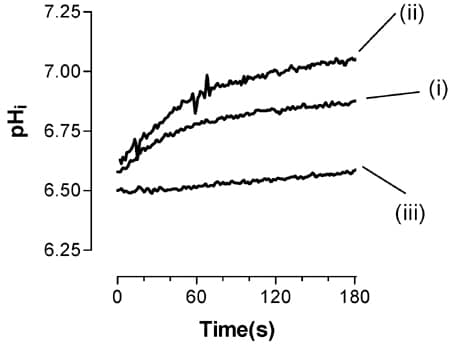Regulation of intracellular pH (pHi), critical for all cells, is particularly important to articular chondrocytes, affecting turnover of cartilage matrix (Wilkins & Hall, 1995) and Ca2+ signalling pathways (Browning & Wilkins, 2002). Homeostasis of pH is therefore relevant to joint physiology. In addition, joint disease can result in perturbations of pHi. Notwithstanding its importance, the mechanisms by which equine articular chondrocytes carry out pH regulation remain unknown. In this communication, we address the mechanisms by which equine chondrocytes respond to an acid load.
Cartilage slices were taken from equine metacarpophalangeal (fetlock) joints of horses killed humanely for other purposes and chondrocytes isolated following digestion with collagenase. pHi was determined fluorimetrically at 37 °C using BCECF (see Wilkins & Hall, 1992). NH4Cl was used to alter pHi. Salines were buffered with Hepes (10 mM; HBS) or HCO3–/CO2 (25 mM, 5% BBS). In some experiments, [Ca2+]i was measured simultaneously using Fura-2 (Browning & Wilkins, 2002).
Under steady state conditions (pHo 7.4) in HBS, pHi was 7.18 ± 0.02 (mean ± S.E.M., n = 6). Following acidification (to approximately 6.70), pH recovered with a time constant of 26 ± 8 s (n = 3; Fig. 1, i). The recovery was inhibited by application of HOE694 (100 µM), a specific inhibitor of the Na+/H+ exchange isoform NHE-1. A small component (ca 19 %) was inhibited by NBD-Cl (100 µM), an inhibitor of H+-ATPase. In BBS, pH recovery was greater (Fig. 1, ii), and a small but consistent rise in pH persisted in the presence of HOE694 (Fig. 1, iii). Intrinsic buffering capacity was ca 20 mmol (l cells)-1 pH unit-1 at steady-state pHi. Finally, when pH was increased (to ca 7.7), there was a parallel increase in [Ca2+]i (ca 60 nM).
The results imply that, in equine chondrocytes, the major part of recovery from an acid load is mediated via NHE-1, with small contributions from H+-ATPase and HCO3–-dependent processes, i.e. HCO3–-Cl– exchange and/or Na+-dependent HCO3– transport. Finally, Ca2+ homeostasis is affected by pHi. We hypothesise that a more complete understanding of pH homeostasis in equine chondrocytes may allow the development of future therapeutic regimes to protect against joint disease.
We thank Pet Plan Charitable Trust, The Slater Fund (Cambridge University), the Sir Halley Stewart Trust and the Arthritis Research Campaign for financial support.

